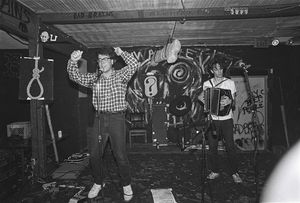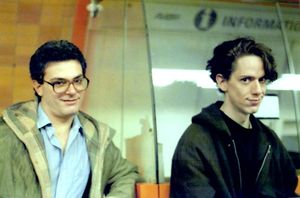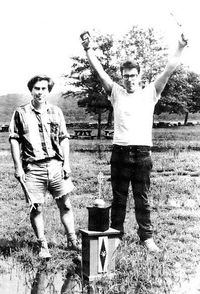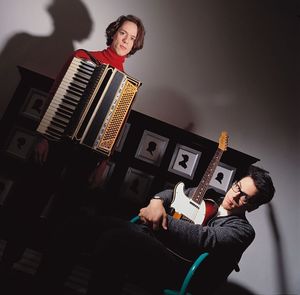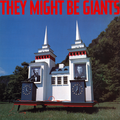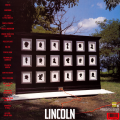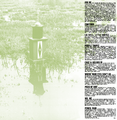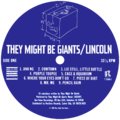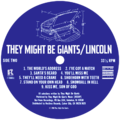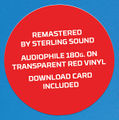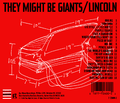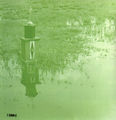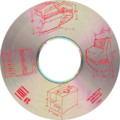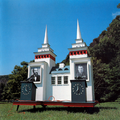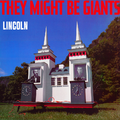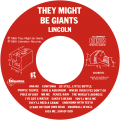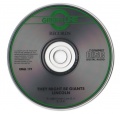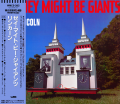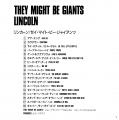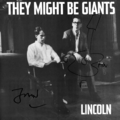Lincoln
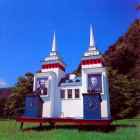 |
Studio album by They Might Be Giants | |||||
| First released | September 25, 1988 Release details / collectors: Show | Hide |
Tracks | 18 | Last album | They Might Be Giants | |
| Label | Bar/None / Restless | Length | 39:32 | Next album | Flood | |
- This page is for They Might Be Giants' second album. For the band of the same name, see Lincoln (Band).
Lincoln is They Might Be Giants' second studio album, released in 1988 on Bar/None through Restless.
Purchase
| Seller | Format | Price | Link |
| Download | 
| ||
| Black Vinyl | 
| ||
| Red Vinyl | 
| ||
|
|
Description
Background
Before the release of They Might Be Giants in late 1986, the band began to demo and perform several new songs which would end up being released on Lincoln. Demos for songs such as "The World's Address" and "Snowball In Hell" would be released on the Dial-A-Song service, while songs such as "Lie Still, Little Bottle"[1], "Pencil Rain"[2] and "Purple Toupee"[3] would be performed at the band's live shows. After the release of They Might Be Giants on November 4, 1986, more songs would enter the setlist during the band's Bring Me The Head Of Kenny Rogers 1987 world tour to promote the album. These shows included songs such as "I've Got A Match" and "Kiss Me, Son Of God"[4], as well as reworked versions of songs from years prior ("You'll Miss Me", "Cowtown")[5]. Performing these songs on tour helped the Johns to practice and develop them further before recording them in studio, which was not afforded to the material on They Might Be Giants as John Flansburgh would mention in a 1988 PR bio:
A lot of the material on the first album was just written for the record and hadn't been audience tested. The big difference with Lincoln is that we've done hundreds of shows since that first record, so as instrumentalists and vocal performers and songwriters, we're just that much more developed.
After the completion of the band's Bring Me The Head Of Kenny Rogers world tour, the band would begin recording new songs that had been performed live throughout the tour at Al Houghton's Dubway Studio, which they had moved to from Studio PASS during the final sessions for They Might Be Giants[6]. Recordings from 1987 to 1988 would also be produced by Bill Krauss, which would be the last he would produce for the band before departing after Lincoln's release.
Recording
Recording for Lincoln began at Dubway Studio as early as October 1987, as indicated in an interview with the PSU's Daily Collegian, which announced that "all new songs" would be slated to appear on the album, as well as songs featured initially on the 1985 Demo Tape[7]. Songs released on the Don't Let's Start EP were recorded a month prior, and aired on the Frank O'Toole Show, suggesting the band may have started recording the album in the summer.
In an interview with the Breaking Point in November 1987, before the release of the Don't Let's Start EP, John Flansburgh announced a January 1988 release date for the album would consist of "as many songs as [the band] can squeeze within a 40 minute frame." Flansburgh also described the album's current sound at the time of the interview[8]:
The sound is going to be much more hi-fi, and there's gonna be less country/western kind of songs and there's gonna be more songs with kind of a swing sound, but outside of that, it's still us!
Similarly to They Might Be Giants, the band would once again use synthetic drum and bass tracks, but would utilize computer controlled sequencing and MIDI technology for the first time. A majority of the album was tracked syncing a MIDI box onto an Apple Macintosh 512k with the MIDI program Performer[9] installed to a Yamaha RX-11/15 drum machine, with an Akai S1000 sampler as well as Casio CZ-101 or a Micromoog for bass parts[10]. Keyboard parts were not sequenced, and were instead played by hand. The band would also make use of the Fairlight CMI for the screams heard in "Cowtown". The band were inspired to use computer programming from Bill Krauss, as mentioned by John Linnell in a 2011 interview:
Our producer, Bill Krauss, had the first generation of Macintosh, the 1984 Mac. He was very on top of all that stuff, and in a way, he kind of forced us. He was like, "You guys gotta learn this. This is going to be essential, especially for sequencing drums," which is what we had been doing using drum machines. He was like, "You should put all your drums on the computer and you’ll have a much easier time doing it." That was the sell that Bill was giving us.
He had the very first edition of a program called Performer, which at that time was just a MIDI program. That was probably 1988, because we started typing the drum programs into Performer right before we made Lincoln. Drum sequencing on the Macintosh was going to be the big change between the first and the second albums. So we learned how to use the Mac by doing sequencing with our producer, Bill Krauss, who had taught us. Then we started sequencing keyboards as well. We were slowly getting our feet wet.
After missing the January 1988 release date, the album was pushed back to March 1988 according to a February 10, 1988 interview with NYU's Washington Square News. In the same interview, "Lie Still, Little Bottle" and "Cowtown" were confirmed for release on the upcoming album. The band continued to work on the album throughout March 1988, pushing the date back once again to May 1988. In an interview with the Kansas City Star on April 11, 1988[11], the new release date, as well as the album's title of Lincoln were revealed by Flansburgh. The title had been based off of the album's working title Lincoln Calling, a pun of the Clash album London Calling. The Johns intended the pun ironically, as they were aware that Lincoln, MA, was not a particularly proud origin.[12] The wide-ranging iconography associated with the shortened title appealed to the band; "We were trying to think of a name that suggested a lot of things."[13].
Guest appearances on the album included the Johns' friend Lisa Klapp, who recited the final line of "Ana Ng"'s bridge over the phone, and the Ordinaires, a nine-piece band who contributed strings and brass to "Kiss Me, Son Of God". The alternate version of the song released on the (She Was A) Hotel Detective EP was originally recorded as a reference for the Ordinaires' instrumental arrangement that band member Fritz Van Orden[14] would provide during the Lincoln tracking sessions. John Linnell recalled seeing the Ordinaires perform live and bringing them in for Lincoln in 2023[15]:
We loved seeing the Ordinaires. We played with them in the same little tiny clubs. They were an enormous band. They had nine members or something like that. We were a two-piece, so it was thrilling because they were this big orchestra and they did these elaborate arrangements. We actually got them to come into the studio and play all the parts for "Kiss Me, Son of God." It was the beginning, I guess, of us doing work with other musicians where we felt like, "Well, what does this track need, or what would be interesting?" And then we'd fantasize about who else we could ask to play on it.
Two songs known to have been left off of Lincoln were "It's Not My Birthday" and "They Might Be Giants", the latter of which was also held off of the band's debut. "It's Not My Birthday" was initially recorded to 8-track, and is present on a Dubway Studio track sheet alongside "Shoehorn With Teeth", "Lie Still Little Bottle", "Ana Ng" and "Purple Toupee"[16], but the song would not make it to the final tracklisting of the album. A self-produced recording would later be released on the They'll Need A Crane EP in 1989, while "They Might Be Giants" would be recorded and released on Flood in 1990.
Recording for the album concluded in May 1988[17], but the band were encouraged by Chris Butler to wait until the Alesis HR-16 was released before mixing the album. Until then, They Might Be Giants had used the Yamaha RX11/15 drum machines heard on their debut album, and would have to replace a majority of the drum sounds that had been sequenced already, pushing back the release date for the album again to Summer 1988. Flansburgh recalled choosing the Alesis HR-16 for Lincoln on Tumblr in 2019:
We followed his advice, which made for what was a fortuitous, but essentially backward process of deciding on the drums and bass sound AFTER the rest of the audio was tracked. (Maybe it would be better described as a second layer of decision making informed by the rest of the tracks of the song, but it definitely made the recordings more powerful and focused) Reflecting on it now, the Alesis actually sonically pulled things BACK from full tilt bone-crushing KAHH! snare sound of the RX15 to either the HR-16s (kind of authentic?) sounding piccolo snare ping or it’s papery white-noisey "brush" snare. Those sounds were simply not available from a drum machine before '88. And while there are production values on the Lincoln album that fully place it squarely in the big 80s, I am grateful that the varied and often smaller sounds of the HR-16 arrived just in time.
A cassette titled "Roughs From 2nd LP, 5/88" would be discovered in the digital collections of the University of Calgary in Canada in 2024[18]. It features six rough mixes of songs from Lincoln with the original Yamaha RX11/15 drum tracks before they were replaced. According to Krauss, the tape was not meant for distribution outside of the band[19].
Packaging
The cover of Lincoln is a photograph taken by Carol Kitman of a shrine built by Brian Dewan—perhaps the most well-known in his series of whimsical, secular shrines. Behind the podiums, John Flansburgh's maternal grandfather, Brigadier General Ralph Hospital (right) and John Linnell's paternal great-grandfather, Lewis T. Linnell (left) are pictured. Flansburgh explained the album cover in a 1989 interview:
Originally the guy who built the shrine wanted to put our photographs in the frame, but we felt funny putting our faces on it, so instead we put the faces of our ancestors on it. It's kind of nice, it's got this church-like quality to it, so there's something reverent about it, and then something very twisted about it.
The shrine was photographed at the Ross Dock Picnic Area of Palisades Interstate Park in New Jersey. Linnell gave his thoughts on the cover in a 1996 interview with Pitchfork:
I wish we could continuously crank out covers that are as artistically satisfying as that one was for us. It seemed really close to us. [...] [The shrine] is not exactly a symbol, but it's a very open-ended metaphor. There are aspects of the cover that key in to where John and I come from in New England. It's a very New England-style roof that the thing has. If you've ever been up there, the steeples and even the federal, dormered windows are really old colonial structures from New England. And there's a general Americana thing with the 13 stars in a circle on the podium, and then Brian just kind of threw in his usual styles. Like, there are Danish-Modern table legs and the electrical cord that plugs in the whole thing. There are modern kitchen drawer fixtures, so it's very contemporary and it's also like the past."
Two slightly different versions of the cover photograph are known to exist: one that was used for domestic releases, and another that was used for all releases outside the United States, with the exception of Australian releases and the Italian CD. The CD cover features only the photograph, whereas the LP cover includes the text THEY MIGHT BE GIANTS, and the cassette adds this and the name of the album. The CD longbox divides the photo into two halves (as the front and back covers).
The majority of domestic Lincoln LPs were packaged with custom inner sleeves, upon which a monochrome photograph of a smaller Lincoln-themed shrine—more of a Lincoln aedicula—was printed (the color of the photograph varied among international releases). Lyrics and credits for the album were also listed on the sleeve. A minority of domestic pressings included the liner notes printed on a separate sheet, rather than the sleeve itself. A page listing differences between LP pressings of Lincoln is available here.
The LP labels, cassette card, CD, and CD back feature diagrams of an accordion and accordion case, which were drawn by John Linnell, who described the origins of the drawing to Pitchfork in 1996:
I think it's a drawing that I made for measurements for my accordion case. If you open it up, on the actual CD, there are pictures of both the case and the accordion. I just did those on yellow legal paper to send to the guy who was building our cases for our first tour, and Flansburgh saved the drawings and we put them on the cover.
Cartoonists Charles Burns and Gary Panter were both individually approached to create the album cover, but neither had the time to do so.[20] Panter's wife Helene Silverman frequently collaborated with the band in the late 1980s and directed the music video for "Purple Toupee".
Release and promotion
Lincoln was released on September 25, 1988 and would be celebrated with a release party at Cave Canem on October 11. When the band returned to touring after the album's release, they would debut a stripped-back stage presence, with the absence of props that had previously been a major feature of the band's shows during touring for They Might Be Giants, although The Stick would return in the following months as an audience participation bit. When asked about the props' removal in an interview with NCSU’s Technician in November 1988, Linnell responded:
"It was getting to be like a comedy act, where people just wanted to hear the punchline and didn't care about the joke. People just wanted us to bring out the props, and they would forget about the music. We want to showcase the songs. The props are meant to underscore and nothing more. The vehicle and not the show."
The album debuted on the Billboard Top Pop Albums chart (now known as the Billboard 200) the week of December 24, 1988 and spent 19 weeks on the chart, peaking at number 89 in 1989. Three singles were produced in support of the album: "Ana Ng" (1988), "They'll Need A Crane" (1989) and "Purple Toupee" (1989). "Santa's Beard" was also advertised by Bar/None as a Christmas single[21], but did not receive its own release, although it was planned to be featured as the B-side to a scrapped "Ana Ng" US single[22].
"Ana Ng", which was the first single by the band to land on any Billboard Chart, spent 9 weeks on the Billboard Modern Rock Tracks Chart, peaking at number 11 in late 1988.
By February 1989, Lincoln had reached 100,000 in album sales[23]. To celebrate the album’s "runaway success", the band would perform at the Puck Building on February 24, 1989 in front of an estimated 1,200 in attendance[24]. In addition, the band would also spend the first half of 1989 performing live in Germany and the United Kingdom in support of the album's release in both countries. Although the band had gotten positive reactions from the international crowds[25], Flansburgh would recall the exhaustive promotion cycle in a 2013 interview:
We could have probably promoted Lincoln for another year but the truth is we were already really tired from touring. And I think we were looking forward to just being home and not being so completely uncomfortable. You can't even look back on our touring in the eighties fondly and go, "Oh, that really was fun," because it really wasn't fun. There was never a contingency made to make sure that we would get somewhere in good shape. Our itinerary would be to drive 14 hours to do a live television show. We got to go to England, but then immediately we'd have publicity to do on arrival, and we literally would be falling asleep sitting in the interview chair.
In the midst of the album's success, They Might Be Giants would be approached by Elektra A&R members Peter Lubin and Susan Drew, the latter of whom had previously scouted the band for PolyGram Records in 1987[26]. After a few discussions, the band would make the jump to the major label in February 1989, announcing their signing at a show at the Paradise Club in Boston. David Weinstein, writer for Brandeis University's newspaper The Justice, wrote about the crowd's reaction to the announcement[27]:
I expected the packed audience to meet this announcement regarding their underground favorites with loud "boos" and murmurs of a "sell-out". I was wrong. The crowd went nuts. In a small way, the fans shared the two Giants' commercial success on Elektra Records.
After returning home from their second German tour in May 1989, the band would begin to record their soon-to-be third album Flood for Elektra Records, with Clive Langer, Alan Winstanley and Roger Moutenot as producers.
Impact
The significance of Lincoln led to its rerelease alongside the band's first album and accompanying B-sides on the Restless compilation Then: The Earlier Years in 1997. They Might Be Giants also toured the album briefly in the 2010s, learning to play all of its songs again live aside from "I've Got A Match." In June 2018, Flansburgh announced the band would be remastering and re-releasing Lincoln.[28] It was released on 180 gram transparent red vinyl in late October 2018.[29] Flansburgh commented that the remaster has "smoothed out EQ and of course more contemporary volume levels." [30]
In 2023, vinyl label Bandbox released a deluxe reissue of Lincoln with an accompanying zine, Bandbox Issue #103. The zine contained an interview called Everything Sticks Like A Broken Record, where John and John took turns recounting the creation of the album and each of its songs.
Track listing
| # | Title | Length | Lyrics | Guitar Tab |
|---|---|---|---|---|
| 1 | Ana Ng | 3:23
|

|

|
| 2 | Cowtown | 2:21
|

|

|
| 3 | Lie Still, Little Bottle | 2:06
|

|

|
| 4 | Purple Toupee | 2:40
|

|

|
| 5 | Cage & Aquarium | 1:10
|

|

|
| 6 | Where Your Eyes Don't Go | 3:06
|

|

|
| 7 | Piece Of Dirt | 2:00
|

|

|
| 8 | Mr. Me | 1:52
|

|

|
| 9 | Pencil Rain | 2:42
|

|

|
| 10 | The World's Address | 2:24
|

|

|
| 11 | I've Got A Match | 2:36
|

|

|
| 12 | Santa's Beard | 1:55
|

|

|
| 13 | You'll Miss Me | 1:53
|

|

|
| 14 | They'll Need A Crane | 2:33
|

|

|
| 15 | Shoehorn With Teeth | 1:13
|

|

|
| 16 | Stand On Your Own Head | 1:16
|

|

|
| 17 | Snowball In Hell | 2:31
|

|

|
| 18 | Kiss Me, Son Of God | 1:54
|

|

|
2013 Australian bonus tracks
The 2013 Australian reissue included a selection of B-sides and rarities previously released on Then: The Earlier Years.
| # | Title | Length | Lyrics | Guitar Tab |
|---|---|---|---|---|
| 19 | It's Not My Birthday | 1:52
|

|

|
| 20 | I'll Sink Manhattan | 2:32
|

|

|
| 21 | Nightgown Of The Sullen Moon | 1:59
|

|

|
| 22 | Hey, Mr. DJ, I Thought You Said We Had A Deal | 3:48
|

|

|
| 23 | Lady Is A Tramp | 1:20
|

|

|
| 24 | Birds Fly | 1:25
|

|

|
| 25 | Hello Radio | 0:55
|

|

|
| 26 | The World's Address (Joshua Fried Remix) | 5:42
|

|
N/A |
| 27 | Kitten Intro | 1:43
|

|
N/A |
| 28 | Weep Day | 1:50
|

|

|
| 29 | The Big Big Whoredom | 1:39
|

|

|
| 30 | I'm Gettin' Sentimental Over You | 1:59
|

|

|
| 31 | Become A Robot | 1:18
|

|

|
| 32 | Which Describes How You're Feeling | 1:13
|

|

|
| 33 | Swing Is A Word | 0:53
|

|

|
| 34 | Doris Cunningham | 0:12
|

|
N/A |
| 35 | Counterfeit Fake | 0:39
|

|
N/A |
| 36 | Schoolchildren Singing Particle Man | 2:05
|

|
N/A |
Trivia
- A part of the Dewan-built shrine from Lincoln's cover can also be seen on the back cover of They'll Need A Crane and was also used as a prop for the band's New Years 1989 show at Quiet Life according to the taper. As of 2021, the shrine currently resides at Brian Dewan's house[31].
- During the replacement of drum sounds for the album, the Macintosh used for sequencing the album exploded due to the temperature of the small studio the band was working in. John Linnell[32]:
We were working in this tiny control room, and it was so hot in the summer that the computer just burned out and this enormous column of smoke started pouring out of it. It was this old-fashioned Macintosh computer that looked like a little TV set. We smelled this awful smell and everyone was like, "What is that?" Suddenly, all this smoke started pouring out of the computer and it just blew up. We were fastidiously backing everything up on these little floppy discs as we worked, so all the work we'd done was preserved.
- In a 1988 PR bio, John Linnell joked that the album title was chosen because it was Jamie Kitman's middle name.
- The vinyl record features lyrics from "Ana Ng" between the run-out grooves on either side of the LP:
- Side 1: "I don't want the world"
- Side 2: "I just want your half"
- The Italian releases of the album have several significant issues. Details concerning the LP labels are outlined here.
Image gallery
Vinyl
Cassette
CD
CD, with diagrams of accordions and a case drawn by John Linnell; some copies are printed in black rather than red
International CD releases
Promotional Material
Bar/None press release, 1988
Other
Lincoln-related photos from the Fall 1991 Info Bulletin
